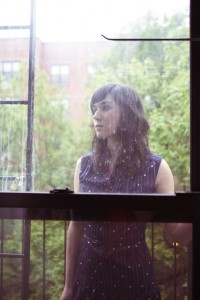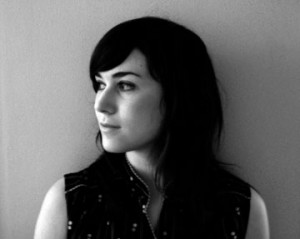Interview with Noveller

Sarah Lipstate is a musician and film maker. She’s only been in New York for a few years, but has already made a name for herself as a strong, independent voice on the guitar. Her primary focus is Noveller, her solo guitar project, which presents gorgeous and evocative sound-scapes that are deliberate and slow building. In an age where so much music is at the click of a mouse, it’s exciting to see a musician who doesn’t care about getting to the point too quickly. In order to fully experience Noveller, you have to be on for the whole ride. Lipstate sat down with me in her Bushwick apartment to talk about Noveller, where it came from, and where it’s going.
Adam: First and foremost, how do you pronounce your stage name?
Sarah: It’s Noveller (Know-vell-er). When I was in college I played in a duo with this guy, and he was really into the idea of us having pseudonyms for the band. So, my pseudonym was “Novella”, which I chose just because I liked the way it sounded. When I started doing solo work, I recorded a track for a compilation called “Women Take Back The Noise”, I had to come up with a name. I was already used to having this Novella name and decided that Noveller of was kind of a nice spin on that.
A: How long ago, do you think the inklings of the music you’re creating now began?
S: I started doing more ambient guitar work when I was 19, at UT in Austin, Texas. I had a four track tape recorder that I had gotten for Christmas from my family, and I remember living in the dorms, setting up my guitar, and plugging into the four track. My friend had given me an Ebow, cause he was like “My uncle gave this to me, I think it’s totally boring, I don’t like it, you can have it.” But I just thought it was really cool, and I could get some really cool sounds with this Ebow. So I would record in my dorm room these sound scape-y experiments, and I didn’t really know any better but I used the same tape for six months, and then one day I was playing it back in my stereo and it got completely destroyed. I’m still kinda sad about that to this day. So yeah, as far back as that. Then eventually I moved for the four track to a recording program on my laptop computer, expanding what kind of sounds I could create at that time with limited gear, and not having that much space to play music out loud
A: When did you start performing that music? It seems that taking the leap from recording endless loops towards trying to do something with that energy live seems pretty different.
S: I didn’t perform live as Noveller until I moved to Brooklyn, in January 2007. Shortly after being here I was invited to play an experimental music festival in Washington, DC called Sonic Circuits. They offered me money, and it was a really cool festival, so I agreed to do it and prepared a set. It was kind of difficult to transition from the endless possibilities of recording and overdubbing, and then finding out how to do that with my double necked guitar and a looping pedal. I had to grow into creating live pieces that I was happy with, creating a full sound with two hands, my guitar and a few pedals. But it’s definitely fun. I think it’s evolved a lot from the first few shows.
A: How much of your music is pre-composed?
S: Everything that I do currently is stuff that I’ve worked on at home, to where I know there’s a structure laid out. It changes every single time I play live, there’s not a set length and I can adapt things wildly, but I know how things are going to start, progress and end for the most part. There have been a few cases where things have gone wrong during a show and I’ve just been like “OK, I’m going to wing the next ten minutes,” and then things get kind of crazy.
A: What can go wrong?
S: What can go wrong (laughs)….well, a lot of my pieces can rely heavily on certain pedals. I have this Moog pedal, a ring modulator, and I played one show where the power supply to that pedal broke, and I couldn’t use it. I use that pedal a lot, it can create this tremolo effect which I use a lot, and I had to work around that and do something completely differently. Or settings get shifted on a delay pedal…It’s when you rely on all these electronics.
A: What are some of the benchmarks in your music that allow you to get through a piece while still changing. Could you talk me briefly through one piece?
S: One piece of mine that’s newer, and I’m really happy with the way it’s turned out is called “St. Powers.” The recorded version is 14 minutes long, and it’s been a staple of my live performance for the past few months. At the start, I lay the guitar flay on a keyboard stand, and I bow the strings with a violin bow to create a loop, that runs throughout the entire piece. Then I use one of my delay pedals and play a chord on the guitar, and it rests over the bed of this drone. I some other bow things with the harmonics on the strings and then at one point, there’s a setting on the looping pedal that I use that drops the loop down to half time, which sounds like it drops an octave. The way the piece ends is that I record some looped harmonic progression over that, and then I trigger it back to regular speed. Since it’s been recorded at half time, it jumps up (pushing the harmonics sound an octave higher). I rely a lot on that one pedal works to create the effect of that piece. I feel like it makes the piece for me. I’ve done versions of it where it’s 9 minutes long, some time it’s 18 minutes long, a lot of repetition. Depending on how I’m feeling, it will change, but that’s the progression of how it goes.
A: Outside of the experimental music scene, how have people in a live setting responded to your music? It seems that especially in the DIY concert culture, the thing of high value is a short song. So if you’re on a very diverse bill, how do fans of the other bands react to a potentially 18 minute song?
S: In most circumstances I like to keep my set around 20 minutes, so I would either play two pieces and that would be one of them, or play three pieces and make that one shorter. I’ve played on some pretty diverse bills.
A: What’s the most absurd bill been?
S: I just played in Stockholm opening up for the Jesus Lizard, and I’ll be opening some shows for them in the US next month.
A: How did that happen?
S: David Sims is the bass player for the Jesus Lizard, and he came to one of my shows in Brooklyn, after I played in Rhys Chatam’s piece for 200 guitars. So, he came to the show and saw me play and contacted me a couple days later asking me to open some shows for them. It was really crazy for me, because I was like “This is amazing! But wait, does this really make sense? Are their fans gonna hate me?” I had faith that it would be a fun experience no matter what, but I was honestly a bit concerned about how their fans would respond to me getting up their doing what I do. So, I got the chance to open for them in Stockholm, because I was already over there playing a noise festival called No Fun Fest. As I was playing people were being respectful and listening. Then after the show a ton of people came up t me and said, “This is really crazy that you’re playing this type of music opening for the Jesus Lizard, but it’s really amazing!” I was really pleasantly surprised by that audience’s response, and I hope people are similar in the US.
A: How do you approach recording a Noveller record?

S: A lot of it is just setting up and trying out new things, improvising and eventually coming up with sounds and textures that I like. It’s really as basic as me picking up the guitar and putting it in a certain tuning. There are three tunings that I use at the moment, so it’s really about picking one, choosing a pedal, then starting a loop. Then after an hour of that, I’ll record something onto my laptop. For the first album I did for No Fun Productions, Carlos Giffoni had me record in a studio. That was pretty cool, though I will say that that record was just one take of each piece, no overdubs. I’m really proud of the fact that I did that.
A: But it almost negates the purpose of the studio.
S: Yeah, It was nice to use the EQs and amplifiers in the studio, a lot better then the setup that I have here, which is really crappy equipment, but yeah, I didn’t really mess around with the pieces. When I record at home I don’t have to rely on the looping pedal, I can play one thing for four minutes, then go back and record on top of that. But I’m really into recording stuff that I can create live, without backing tracks. I like the challenge of being able to create this piece live.
A: And by the nature of that you have to think of it as introducing one element of the time.
S: Exactly. When you see me play, you definitely are witnessing the process. It might take a little bit of time, but hopefully some people will be interested in that. You’re hearing this sound, I’m making it right now, then I’m gonna loop it, and eventually you’ll see the big picture.
A: I think that also makes experimental music more accessible to people, because then it’s not all of a sudden being bowled over by a barrage of sound. No one will ever be able to fully figure out what you’re doing, but by giving people these building blocks seems more inclusive.
With the essence of improvisation behind your approach, do you ever listen to other music that’s from that same approach of spontaneous creation?
S: Yeah, I think music rooted in improvisation is really exciting. I don’t listen to it that often, but I was really excited about the stuff I saw at No Fun Fest Sweden. It was a lot of spontaneous sound, abstract sound, bizarre sound, and power electronics. Especially experiencing it in a live setting, it was really fun. It’s definitely a source of inspiration from me and it’s something I enjoy listening to other people do.
-Adam Schatz
Adam Schatz is the founder and managing editor of SearchAndRestore
Noveller is performing as part of Manhattan New Music Project’s Interactive Music Series at 8:30pm this Thursday, October 8th at X-Initiative. This show is free admission but RSVP is required.
For more information on Noveller and her music please visit her website.